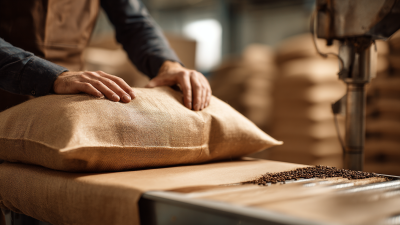Essential Features to Look for in Coffee Packaging Bags for Maximum Freshness
In the quest for the perfect cup of coffee, freshness is paramount, and the importance of high-quality Coffee Packaging Bags cannot be overstated. These bags play a crucial role in preserving the rich aromas and flavors of coffee beans, making them an essential consideration for both consumers and roasters alike. When selecting packaging, it is vital to look for features that ensure optimal freshness, such as one-way valves that allow gases to escape while preventing air from entering, resealable closures for convenience, and materials that effectively block light and moisture. Understanding these key characteristics can empower coffee lovers to make informed choices, ultimately enhancing their coffee-drinking experience. In this article, we will explore the essential features to look for in Coffee Packaging Bags to ensure that your favorite brew maintains its delicious quality from the roastery to your cup.

Key Characteristics of Coffee Packaging Materials for Optimal Freshness
When it comes to preserving the freshness of coffee, the choice of packaging materials is paramount. According to a report by the Specialty Coffee Association, nearly 50% of flavor and aroma degradation can occur within weeks if coffee is not stored correctly. Therefore, selecting bags with key characteristics is essential for optimal freshness.
A crucial feature is the inclusion of a one-way valve, which allows gases released during the degassing process to escape without letting air in. This is particularly important for freshly roasted beans, as it helps prevent the buildup of pressure while maintaining an airtight seal for the coffee. Additionally, materials with high barrier properties like foil or multi-layer laminates can effectively keep out moisture, light, and oxygen, further extending shelf life.

Furthermore, the size and design of the packaging play a significant role. Smaller bags encourage more frequent purchases, ensuring that customers enjoy their coffee at peak freshness. Moreover, investing in opaque materials can shield beans from light exposure, which is known to degrade coffee quality rapidly.
Tip: Always check for packaging certifications like ASTM D-6400, which assures that the material meets industry standards for preservation and sustainability.
The Importance of Barrier Properties in Coffee Bags to Preserve Flavor
When it comes to preserving the rich flavors of coffee, the choice of packaging plays a critical role. The barrier properties of coffee bags are paramount in preventing exposure to elements that can degrade taste. A high-quality coffee bag should feature materials that effectively block out moisture, light, and oxygen, which are known culprits in flavor deterioration. For instance, stand-up pouches with multi-layer construction are often utilized, as they provide an excellent barrier while also being convenient for consumers.
Moreover, the inclusion of one-way degassing valves in coffee bags enhances their functionality by allowing carbon dioxide to escape while keeping oxygen out. Freshly roasted coffee emits gas, and a bag that can accommodate this release without compromising its integrity is essential. By focusing on these barrier properties, coffee packaging not only ensures longer shelf life but also maintains the vibrant taste profile that coffee lovers crave. Investing in bags that prioritize these features ultimately leads to a superior coffee experience from the moment it is opened.
Essential Features to Look for in Coffee Packaging Bags for Maximum Freshness
This chart depicts the essential features to consider in coffee packaging bags to ensure maximum freshness. Each feature is rated on a scale of 1 to 10, highlighting the significance of barrier properties, material type, seal quality, valve functionality, and size options in preserving coffee flavor.
Ventilation Features: Balancing Freshness and Gas Release in Coffee Packaging
When it comes to coffee packaging bags, the incorporation of ventilation features is essential for maintaining maximum freshness. Coffee beans produce gases that can lead to spoilage if not appropriately managed. Ventilation systems allow these gases to escape without compromising the integrity of the packaging, ensuring that the coffee inside remains vibrant and full of flavor. This balance between gas release and protection from external elements is paramount for both roasters and consumers.
Drawing inspiration from innovations in other food packaging, such as vented pouches used for raw organic products, the coffee industry stands to benefit from similar advancements. Just as these pouches help retain the freshness of items like unpasteurized kraut and kimchi by allowing for necessary gas exchange, coffee bags designed with effective ventilation capabilities can significantly enhance the longevity and taste of the beans. By prioritizing such features during the packaging process, manufacturers can ensure that their products deliver the rich, aromatic experience that coffee lovers expect.
Reusability and Sustainability Considerations in Coffee Bag Design
When considering coffee packaging bags, the focus on reusability and sustainability is becoming increasingly paramount. Research indicates that the coffee industry contributes significantly to global waste, with single-use packaging being a major culprit. Sustainable designs, such as recyclable, biodegradable, and compostable bags, are essential to mitigate this environmental impact. A recent study revealed that 73% of consumers prefer brands that emphasize sustainable packaging, demonstrating the demand for eco-friendly options in the coffee market.
Additionally, reusable packaging systems have shown promise in promoting circular economy practices within the coffee supply chain. Initiatives that incorporate reusable bags not only help reduce overall waste but also foster consumer loyalty by aligning with their values on sustainability. The challenge, however, remains: while many consumers express interest in reusing and refilling, actual behavior often falls short. A survey found that despite 67% of consumers pledging to engage with reusable packaging, only a fraction consistently follows through. Fostering a stronger connection between consumer intent and action will be critical in driving the adoption of sustainable coffee packaging practices.
Sealing Techniques That Enhance Shelf Life and Freshness of Coffee Products
When it comes to preserving the freshness of coffee, the sealing techniques used in packaging are paramount. Coffee is highly sensitive to oxygen, moisture, and light exposure, all of which can lead to rapid degradation of flavor and aroma. According to a report by the Specialty Coffee Association, improperly sealed packaging can reduce the shelf life of roasted coffee beans by up to 50%. Therefore, choosing the right sealing method is essential for maintaining the quality of coffee products.
One of the most effective sealing techniques is the use of one-way valves, which allows gases produced during the roasting process to escape while preventing air from entering. This is crucial because even the slightest contact with oxygen can initiate the oxidation process. Additionally, vacuum sealing is another preferred method, drastically minimizing the amount of air within the bag. The International Coffee Organization highlights that vacuum-sealed coffee can remain fresh for months compared to standard packaging, which may lose its optimal flavor within weeks. By prioritizing these sealing technologies, producers can ensure that their coffee retains its delicious profile, ultimately leading to satisfied customers.

Related Posts
-

Ultimate Guide to Selecting the Best Coffee Packaging Bags for Global Sourcing Success
-

7 Innovative Ways to Enhance Your Liquid Pouch Packaging Experience
-

Global Certification Trends in Food Packaging Equipment 2023 Insights for Buyers
-

What is the Importance of Package Printing in Modern Marketing Strategies
-

Advantages of Choosing the Best Package Printing for Your Business
-

Unlocking Global Opportunities: Insights from the 137th Canton Fair for Packaging Printing Suppliers
